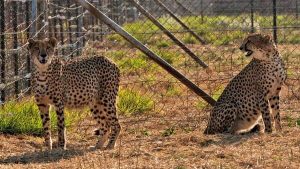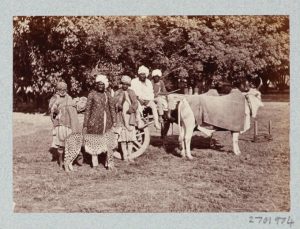17 Sep After more than 70 years, Cheetahs will again walk on the Indian soil
Context
After more than 7 decades of extinction from India, Cheetahs have returned to Indian soil. This morning saw a landmark event – the arrival of 8 African Cheetahs in India. The Cheetahs arrived from Namibia and landed in Gwalior for being taken to the Kuno Palpur National Park. Out of the 8 Cheetahs that arrived, 5 are females while 3 are male.

(Image Courtesy: livemint)
Background
- Cheetahs have an ancient history in India with the first reference dating back to the the Neolithic period. A Neolithic cave painting at Chaturbunj Nala in MP depicts a ‘slender spotted feline being hunted’.
- ‘Cheetah’ is believed to have originated from Sanskrit word chitrak, which means ‘the spotted one’.
- In the medieval era, the Mughal emperor Akbar is believed to possess 1,000 cheetahs which were used for hunting blackbucks and gazelles. This move was continued by Jahangir.
- The British rule didn’t help for protection of Cheetahs either and some British even shot them for trophy hunting.
- By the beginning of the 20th century, only a few hundred Indian Cheetahs were left, rest were wiped out.
- Maharaja Ramanuj Pratap Singh Deo of Koriya princely state is believed to have hunted down and shot the last three recorded Asiatic cheetahs in India.
- In 1952, The cheetah was officially declared extinct by the Indian government.

Re-introduction and Project Cheetah
- India has been trying to bring back Cheetah since a long time. Talks were carried out with Iran in 1970s to bring Asiatic cheetah to India in exchange for Asiatic lions but this couldn’t manifest into any action.
- Attempts were again made in 2009 when the then Environment Minister endorsed plan to reintroduce Cheetah but this was stayed by the Supreme Court citing that a detailed study needs to be conducted and produced before taking this big step.
- Project Cheetah is an ambitious project undertaken by the Government of India with the objective to re-establish the species in its historical range in India. This was approved by the Supreme Court as a pilot program and allowed reintroduction of cheetahs on an “experimental basis”
- India signed an MOU with the Republic of Namibia in 2020 whereby the latter agreed to donate the eight Cheetahs to start the program. Another batch is expected to arrive from South Africa once details between the two countries are finalized.
- Amongst the 10 surveyed sites of the central Indian states, Kuno Palpur National Park (KNP) in Madhya Pradesh was identified as the best suited one. The reasons for this were its suitable habitat and adequate prey base, lack of human settlements and ample deciduous open forest landscape.
Translocation and associated issues
Translocation is not a rare phenomena and is often done to preserve species and re-populate its old habit or that of a similar kind. For example the southern white rhinos were transported in various places in Africa from KwaZulu-Natal. Similarly, Kaziranga Rhinos were translocated to Manas to build a new population in recent times. Such have been success stories. However, inter-continental translocations are no so common and certain risks are associated with translocation namely:
- Genetic Diversity: A genetically diverse population of species is ideally suited for building a new population elsewhere. But when the source population is itself small in number, it becomes difficult to build a new population of genetically suitable animals due to lack of gene diversity and inbreeding further increases health risks.
- Habitat: The habitat should match the original one from where the animals are brought as any difference can cause stress and difficulty to cope in the new environment.
- Prey Base: There should be sufficient prey base and density for the Carnivorous population to survive.
- Area: a single cheetah requires 100 sq km as its territory. Due to large scale construction, deforestation and industrialisation, it may become difficult to sustain a stable cheetah population.
- Homing instinct: It refers to an animal’s innate ability to return to its territory after traveling away from it. This can lead to man-animal conflict as the animal displaced from its original site wanders in new areas in search of its old habitat. This was witnessed in 2009 when a young tiger was moved from Pench to Panna and it set its journey of over 400 km to travel back to Pench when authorities had to intervene to intercept it and bring it back to Panna.
Preparations made for successful Cheetah Translocation
- Extensive health check ups were done of the 8 Cheetahs in Namibia to ensure they were fit to be flown to India. They were checked for diseases and completion of vaccination.
- Indian forest officers and wildlife experts were trained by expert teams from Namibia and South Africa on the handling, breeding, rehabilitation, medical treatment and conservation of cheetahs.
- After arrival, they will be radio collared and monitoring would be done through satellites
- Each Cheetah will have a dedicated monitoring unit 24 hours a day.
- Heavy security arrangements are made like presence of drone squads and military personnel to prevent poaching
- Government has launched the ‘Cheetah Mitra’ campaign whereby volunteers would work to increase awareness about Cheetah among people.
- Cheetahs will be first released into a quarantine enclosure where they will be kept for a month after which they will be shifted to bigger enclosure till they adapt to the new environment before being released into Kuno Palpur National Park
Significance of the Cheetah reintroduction
- It will help Restore India’s historic evolutionary balance. Cheetah had been an integral part of India and this move will restore it to its historic glory.
- It will help in developing a Cheetah metapopulation within India and contribute to increasing the global Cheetah number.
- The cheetah is a flagship grassland species and its conservation will also help to preserve other grassland species in the predator food chain.
- It will also help to protect the grasslands of India which is the habitat of Cheetahs
Way Forward
While a successful Cheetah diplomacy has ensured in getting the big cat back to India, the future course will be determined by proactive conservation efforts and coordination of all stakeholders. Once the population in Kuno National Park adapts to the region and population increases, the Indian government will expand the efforts to reserves in other parts of the country also. It is hoped that Project Cheetah will follow the footsteps of Project Tiger to be a success story.
Sources:
https://bit.ly/3eWV5A9 (Indian Express)(How cheetahs went extinct in India, and how they are being brought back)
https://bit.ly/3LpPLS6 (The Daily Guardian)(Project Cheetah: PM Modi to introduce Cheetahs brought from Namibia by Boeing 747)
https://bit.ly/3xv4eGi (PIB)(Cheetahs are coming back to India)
https://bit.ly/3eX3tQf (The Print)(70 years after they went extinct, cheetahs return to India in world’s largest conservation trial)
(Indian Express) (why fingers are crossed about first transcontinental mission of its kind by Jay Mazoomdaar)
Plutus IAS current affairs eng med 17th Sep 2022



No Comments